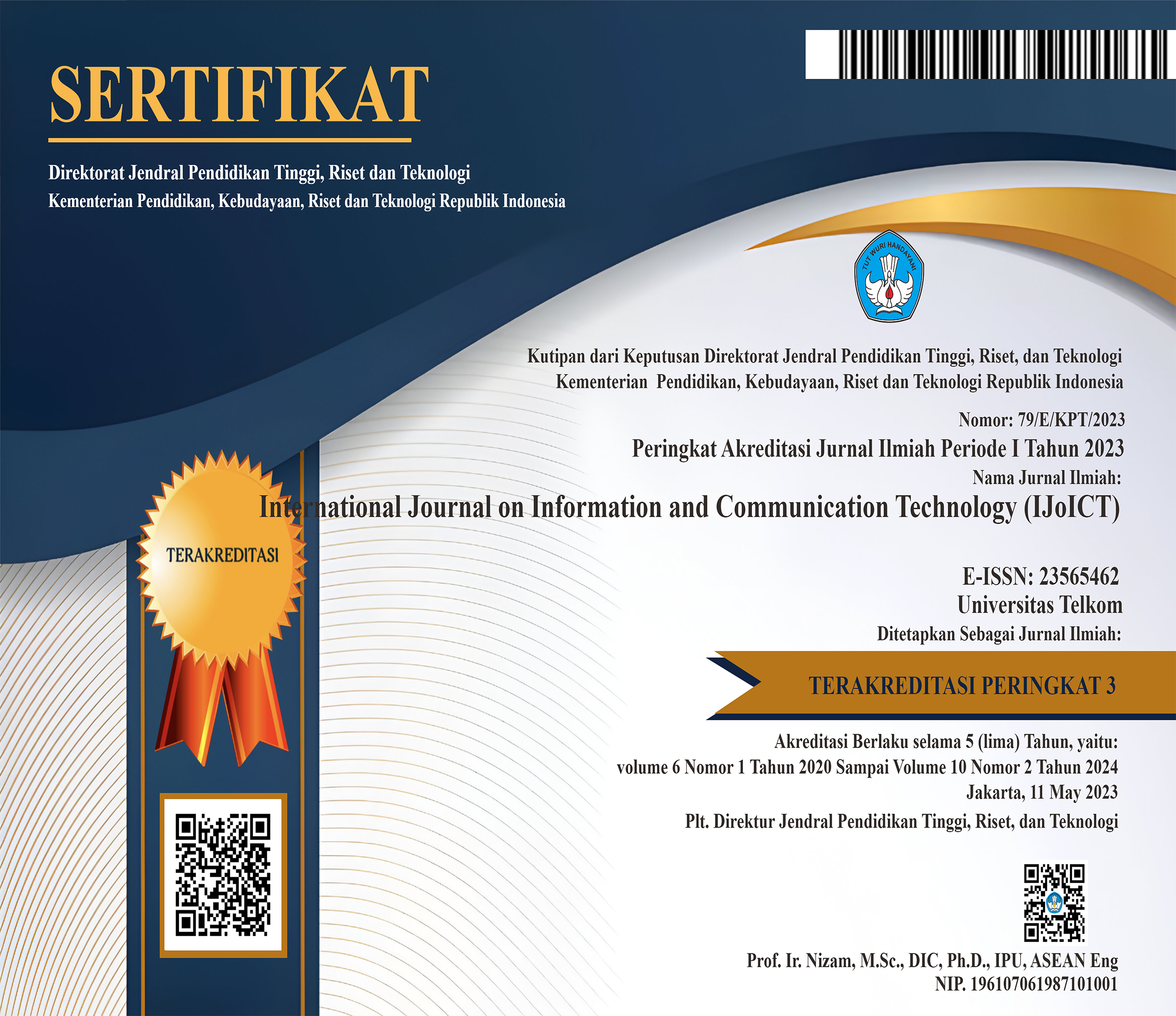Multi Aspect Sentiment Analysis of Mutual Funds Investment App Bibit Using BERT Method
 Abstract views: 460
,
Abstract views: 460
,
 pdf downloads: 294
pdf downloads: 294
Abstract
With the rapid development of technology, an investor no longer needs to visit investment companies to make investments. Investors can conduct all investment transactions through their smartphone screens. Bibit is one investment application that can help investors invest in mutual funds. There are many reviews given by users every day, therefore, aspect-based sentiment analysis is needed to identify the aspects and sentiments of users from each review. BERT is one popular text classification method that currently has good performance. Therefore, aspect-based sentiment analysis will be carried out in this study using the BERT method with pre-trained IndoBERT on Bibit application reviews. From the multi-aspect sentiment analysis classification results, the service aspect had the highest average accuracy score of 0.92, the user satisfaction aspect had an average accuracy score of 0.87, and the system aspect had the lowest average accuracy score of 0.75. From the sentiment analysis results, the company can improve the system and service aspects of the Bibit application to provide better service & functionality.
Downloads
References
[2] C. H. Yutika, A. Adiwijaya, and S. Al Faraby, “Analisis Sentimen Berbasis Aspek pada Review Female Daily Menggunakan TF-IDF dan Naïve Bayes,†JURNAL MEDIA INFORMATIKA BUDIDARMA, vol. 5, no. 2, pp. 422–430, Apr. 2021, doi: 10.30865/MIB.V5I2.2845.
[3] H. H. Do, P. W. C. Prasad, A. Maag, and A. Alsadoon, “Deep Learning for Aspect-Based Sentiment Analysis: A Comparative Review,†Expert Syst Appl, vol. 118, pp. 272–299, Mar. 2019, doi: 10.1016/J.ESWA.2018.10.003.
[4] M. P. Geetha and D. Karthika Renuka, “Improving the performance of aspect based sentiment analysis using fine-tuned Bert Base Uncased model,†International Journal of Intelligent Networks, vol. 2, pp. 64–69, Jan. 2021, doi: 10.1016/J.IJIN.2021.06.005.
[5] K. S. Nugroho, A. Y. Sukmadewa, H. W. DW, F. A. Bachtiar, and N. Yudistira, “BERT Fine-Tuning for Sentiment Analysis on Indonesian Mobile Apps Reviews,†ACM International Conference Proceeding Series, pp. 258–264, Jul. 2021, doi: 10.1145/3479645.3479679.
[6] M. F. Mubaraq and W. Maharani, “Sentiment Analysis on Twitter Social Media towards Climate Change on Indonesia Using IndoBERT Model,†JURNAL MEDIA INFORMATIKA BUDIDARMA, vol. 6, no. 4, pp. 2426–2431, Oct. 2022, doi: 10.30865/MIB.V6I4.4570.
[7] S. González-Carvajal and E. C. Garrido-Merchán, “Comparing BERT against traditional machine learning text classification,†May 2020, Accessed: Mar. 27, 2023. [Online]. Available: https://arxiv.org/abs/2005.13012v2
[8] D. S. Bimaputra and E. Sutoyo, “Aspect-Based Sentiment Analysis of Hotels in Bali on Tripadvisor Using BERT Algorithm,†International Journal of Advances in Data and Information Systems, vol. 4, no. 2, Apr. 2023, doi: 10.25008/IJADIS.V4I2.1284.
[9] P. F. Supriyadi and Y. Sibaroni, “Xiaomi Smartphone Sentiment Analysis on Twitter Social Media Using IndoBERT,†JURIKOM (Jurnal Riset Komputer), vol. 10, no. 1, pp. 19–30, Feb. 2023, doi: 10.30865/jurikom.v10i1.5540.
[10] E. Lopes, L. Freitas, G. Gomes, G. Lemos, L. Hammes, and U. Corrêa, “Exploring BERT for Aspect-based Sentiment Analysis in Portuguese Language,†Proceedings of the International Florida Artificial Intelligence Research Society Conference, FLAIRS, vol. 35, 2022, doi: 10.32473/FLAIRS.V35I.130601.
[11] H. Tan, B. Zhang, H. Zhang, and R. Li, “The Sentencing-Element-Aware Model for Explainable Term-of-Penalty Prediction,†Lecture Notes in Computer Science (including subseries Lecture Notes in Artificial Intelligence and Lecture Notes in Bioinformatics), vol. 12431 LNAI, pp. 16–27, 2020, doi: 10.1007/978-3-030-60457-8_2/TABLES/6.
[12] S. González-Carvajal and E. C. Garrido-Merchán, “Comparing BERT against traditional machine learning text classification,†May 2020, doi: 10.48550/arxiv.2005.13012.
[13] Y. Zhuang and J. Kim, “A bert-based multi-criteria recommender system for hotel promotion management,†Sustainability (Switzerland), vol. 13, no. 14, Jul. 2021, doi: 10.3390/SU13148039.
[14] J. Devlin, M.-W. Chang, K. Lee, K. T. Google, and A. I. Language, “BERT: Pre-training of Deep Bidirectional Transformers for Language Understanding,†Proceedings of the 2019 Conference of the North, pp. 4171–4186, 2019, doi: 10.18653/V1/N19-1423.
[15] “BERT Fine-Tuning Tutorial with PyTorch · Chris McCormick.†https://mccormickml.com/2019/07/22/BERT-fine-tuning/ (accessed May 08, 2023).
[16] S. Mardiana, J. H. Tjakraatmadja, and A. Aprianingsih, “International Journal of Economics and Financial Issues DeLone-McLean Information System Success Model Revisited: The Separation of Intention to Use-Use and the Integration of Technology Acceptance Models,†International Journal of Economics and Financial Issues, no. 5, pp. 10–11, 2015, [Online]. Available: http:www.econjournals.com
[17] W. H. DeLone and E. R. McLean, “Information Systems Success: The Quest for the Dependent Variable,†https://doi.org/10.1287/isre.3.1.60, vol. 3, no. 1, pp. 60–95, Mar. 1992, doi: 10.1287/ISRE.3.1.60.
[18] M. A. Rosid, A. S. Fitrani, I. R. I. Astutik, N. I. Mulloh, and H. A. Gozali, “Improving Text Preprocessing For Student Complaint Document Classification Using Sastrawi,†IOP Conf Ser Mater Sci Eng, vol. 874, no. 1, p. 012017, Jun. 2020, doi: 10.1088/1757-899X/874/1/012017.
[19] P. Nandwani and R. Verma, “A review on sentiment analysis and emotion detection from text,†Soc Netw Anal Min, vol. 11, no. 1, pp. 1–19, Dec. 2021, doi: 10.1007/S13278-021-00776-6/FIGURES/5.
[20] M. Theo, A. Bangsa, S. Priyanta, and Y. Suyanto, “Aspect-Based Sentiment Analysis of Online Marketplace Reviews Using Convolutional Neural Network,†IJCCS (Indonesian Journal of Computing and Cybernetics Systems), vol. 14, no. 2, pp. 123–134, Apr. 2020, doi: 10.22146/IJCCS.51646.
[21] M. Kuhn and K. Johnson, “Applied predictive modeling,†Applied Predictive Modeling, pp. 1–600, Jan. 2013, doi: 10.1007/978-1-4614-6849-3/COVER.

This work is licensed under a Creative Commons Attribution 4.0 International License.
Manuscript submitted to IJoICT has to be an original work of the author(s), contains no element of plagiarism, and has never been published or is not being considered for publication in other journals. Author(s) shall agree to assign all copyright of published article to IJoICT. Requests related to future re-use and re-publication of major or substantial parts of the article must be consulted with the editors of IJoICT.









.png)

.jpg)




